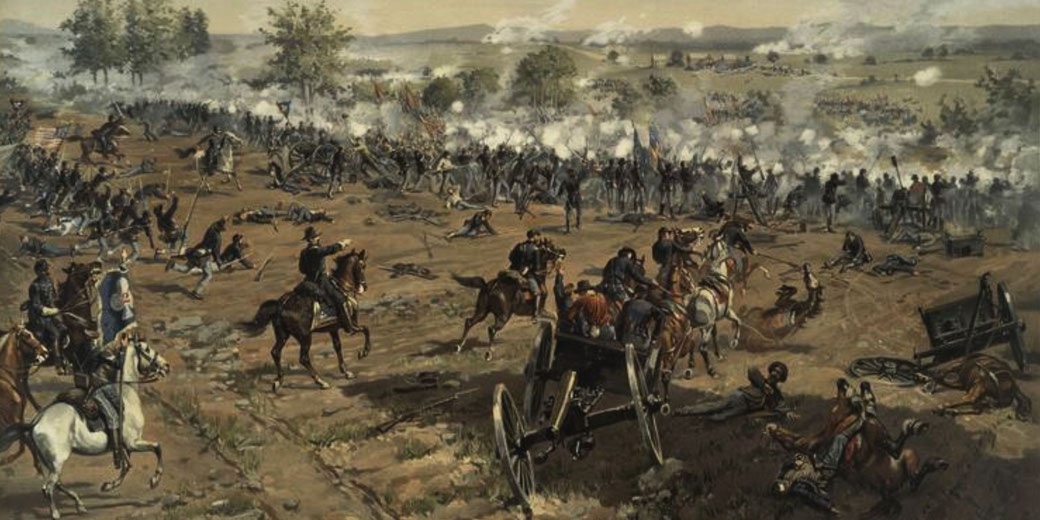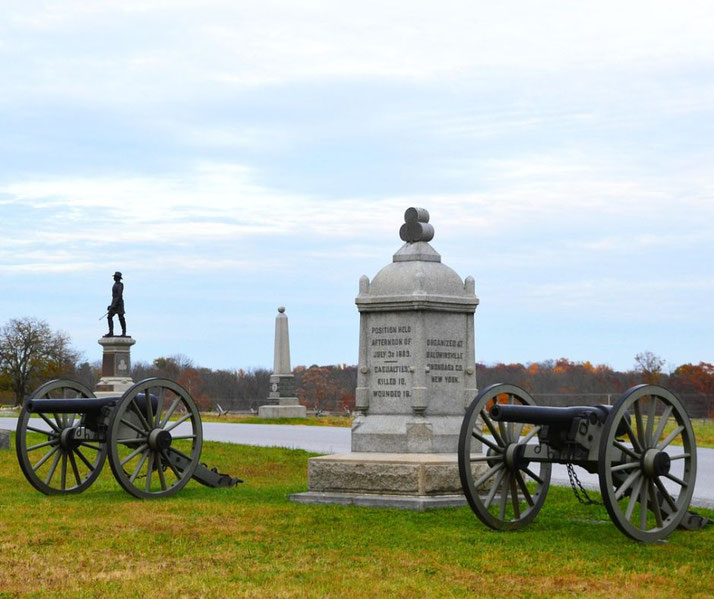The Battle of Gettysburg: The most important turning point of the Civil War?

The Battle of Gettysburg took place from 1 to 3 July 1863, in and around the town of Gettysburg, Pennsylvania. It involved over 165,000 troops (about 90,000 Union soldiers and 75,000 Confederates), and this became the largest battle of the American Civil War.
Over three days, intense fighting unfolded across hills, ridges, and open farmland. The Union army secured a major victory that ended Lee’s second invasion of the North and halted Confederate progress.
What were the causes of the Battle of Gettysburg?
General Lee considered a northern invasion necessary after previous Confederate victories had failed to end the war.
Confederate forces had performed well in Virginia, yet pressure mounted in the Western theatre, where Union troops advanced along the Mississippi River.
Lee believed that a risky advance into Pennsylvania would relieve the burden on Virginia, allow his army to gather supplies from untouched Northern territory, and threaten cities, such as Harrisburg.
He hoped these moves would disrupt Union plans and create political pressure for peace in the North.
After the Battle of Chancellorsville, in May 1863, Lee felt confident in his army’s ability to win again.
The Union command appeared poorly organised, and President Lincoln had just replaced General Hooker with General Meade.
Lee saw an opportunity to deliver a severe defeat on Northern soil. He hoped such a victory might influence public opinion in the Union states and possibly prompt Britain or France to offer diplomatic backing.
In the final days of June, Union forces tracked Lee’s movements and followed the Confederate army into Pennsylvania.
While both sides moved cautiously, neither intended to fight a major battle at Gettysburg.
However, the place where several roads met in the town made a clash likely once both armies arrived in force.
The key commanders and leaders of the battle
General Robert E. Lee was in command of the Confederate Army of Northern Virginia, and his battlefield successes and personal leadership had earned him respect for his leadership and the loyalty of his officers.
He believed his men could overcome the odds, and he remained committed to offensive tactics that had earlier brought victory.
On the Confederate right, General James Longstreet was Lee’s senior corps commander.
He disagreed with Lee’s plan for a frontal assault and preferred to lure Union forces into attacking.
Despite his objections, Longstreet followed orders and prepared his divisions for the costly battle on 2 July.
Toward the centre and left of the Confederate lines, General Richard S. Ewell commanded the Second Corps.
He had taken over after the death of General Stonewall Jackson and faced pressure to match the abilities of the general before him.
His decision on the first day of battle to avoid assaulting Cemetery Hill has drawn criticism, though later historians have argued that his exhausted forces and lack of support justified the delay.
Lee had given him the choice to take Cemetery Hill “if practicable,” a vague order that led to inaction during a critical moment.
In the Union ranks, General George G. Meade had accepted command only three days before the fighting began.
Despite limited readiness time, Meade responded to the situation with controlled focus that allowed him to judge the battlefield clearly, and then he moved his forces into strong defensive positions along the high ridges south of Gettysburg.
After the death of General John F. Reynolds on the first day, General Winfield Scott Hancock took charge of stabilising the Union centre.
His leadership was critically important, particularly during the repulse of Pickett’s Charge on the final day of the battle.
Day One: Initial Engagements (July 1, 1863)
Early in the morning on 1 July, Union cavalry under General John Buford arrived on the ridges west of Gettysburg.
Buford observed Confederate infantry approaching from the northwest and chose to hold the ground until additional Union troops arrived.
His decision delayed the Confederate advance and allowed the Union I Corps to arrive in support.
In the late morning, Confederate General Henry Heth led his division toward the town.
His troops clashed with Union defenders near McPherson’s Ridge. As more Union units joined the fight, General John Reynolds helped direct the defence, but he was killed while deploying his men.
During the afternoon, additional Confederate troops under General Ewell advanced from the north.
They pushed back Union XI Corps and forced a retreat through the town. As Union forces withdrew, they regrouped on Cemetery Hill and established a strong defensive line.
In the final hours of daylight, Confederate commanders assessed their position.
Lee hoped for an opportunity to seize the high ground, but Ewell chose to hold back from attacking Cemetery Hill without further support.
Confederate forces held the town, yet the Union army controlled the more favourable ground.
Day Two: Fierce Fighting on the Flanks (July 2, 1863)
In the early morning hours of 2 July, Lee planned a double attack from both sides.
He ordered Longstreet to strike the Union left, while Ewell would assault the Union right at Culp’s Hill.
Lee aimed to collapse the flanks and force a retreat from Cemetery Ridge.
During the afternoon, Longstreet launched his assault. Fighting broke out in multiple locations, including Devil’s Den, the Peach Orchard, and the Wheatfield.
Union forces suffered heavy casualties, but they resisted repeated attacks. On the far left, Colonel Joshua Chamberlain and the 20th Maine defended Little Round Top from Confederate troops under General Hood.
After repelling multiple waves and facing dwindling ammunition, Chamberlain ordered a bayonet charge that drove back the attackers.
Later that evening, Ewell’s corps began its assault on the Union right. Confederate troops attacked East Cemetery Hill and parts of Culp’s Hill, capturing several lower positions before additional Union troops arrived.
Although they held some ground overnight, Union forces retained the upper slopes and prepared to take back other areas at dawn.
At the end of the day, both armies had endured very high losses. The Union lines stayed together, but their flanks had been under serious pressure.
Lee prepared for a final attempt to break the centre of the line.
Day Three: Pickett's Charge and the Climax (July 3, 1863)
During the morning of 3 July, Union troops counterattacked at Culp’s Hill and recaptured lost ground.
Lee, who had become convinced that Union reinforcements had shifted to the flanks, turned his attention to the centre of the enemy line on Cemetery Ridge.
In the early afternoon, Confederate artillery began a lengthy bombardment aimed at weakening the Union centre.
The artillery fire stretched for nearly two hours and consumed thousands of rounds.
However, Union artillery responded effectively and maintained its strength.
Shortly after the bombardment ended, General George Pickett led his division forward as part of a massive infantry assault.
He was joined by divisions under Brigadier General James Johnston Pettigrew and Major General Isaac R. Trimble, who assumed command after Generals Heth and Pender had been wounded.
Together, they formed a line of nearly 15,000 men. They advanced over open ground under intense gunfire from Union artillery and rifles.
Few Confederates reached the stone wall at the ridge’s crest, later called the "High Water Mark of the Confederacy."
Most were shot down during the long advance or captured after brief hand-to-hand combat.
The charge collapsed with severe losses, and those who survived the retreat returned in disarray.
General Alexander Hays, who was in command of a division near the Union centre, oversaw the successful repulse of the attack.
In the evening, Lee met with his generals and took full responsibility for the failure.
Meade did chose to avoid an aggressive pursuit, but the Confederate army had suffered a defeat it could not afford to repeat.
The horrific casualties and losses
The Battle of Gettysburg resulted in over 50,000 casualties, making it the bloodiest engagement of the war.
Union losses included about 3,155 killed, 14,531 wounded, and 5,369 missing.
Confederate casualties reached approximately 3,903 killed, 18,735 wounded, and 5,425 missing, and included many senior officers.
In the fields around Gettysburg, surgeons operated under terrible conditions.
Without reliable anaesthesia or sanitation, they performed amputations using basic tools.
Many wounded died of infection, and the sounds of cries of those who were suffering echoed for days.
In the days that followed, townspeople helped bury the dead. Union bodies were eventually moved to a formal cemetery, but many Confederate soldiers remained in scattered graves.
The smell of decay lingered in the summer heat, and the emotional toll of the battle haunted residents for years.
Gettysburg’s 2,400 civilians faced serious losses of livestock and crops, while schools, barns, and churches were changed into makeshift hospitals.
Among the Confederate ranks, the loss of experienced soldiers and officers caused serious harm.
Lee’s army never regained its full strength. In contrast, Union forces received reinforcements more easily and began to shift from defensive operations to sustained offensives.

Why did Lincoln give the famous Gettysburg Address?
On 19 November 1863, President Lincoln travelled to Gettysburg to take part in a ceremony which was meant to dedicate the Soldiers’ National Cemetery.
Though Edward Everett delivered the main speech, Lincoln had been invited to give "a few appropriate remarks," and his brief address became the part of the occasion people remembered most.
With just 272 words, Lincoln gave new meaning to the war. He referred to the nation’s founding beliefs and declared that the war must ensure that freedom would survive and equality would be upheld.
His address honoured the dead without which would have glorified war.
Rather than focusing on military victory, Lincoln described the Union’s cause as a continuation of the effort to preserve American self-government.
He called on listeners to dedicate themselves to the unfinished work of those who had fallen.
Edward Everett later told Lincoln, “I should be glad if I could be proud that I came as near to the central idea of the occasion in two hours as you did in two minutes.”
After the speech, reactions were mixed, yet public admiration grew in the weeks that followed.
The Gettysburg Address became a plain expression of what Americans believed and helped bring Americans together during a period of hardship.
How Gettysburg influenced the Civil War
From July 1863 onward, Lee no longer attempted another offensive into Union territory.
The defeat at Gettysburg ended any genuine chance for a Confederate military solution. Lee’s army returned to Virginia weakened and discouraged.
At the same time, the victory improved morale in the North. The Union had proven it could repel a major Confederate assault and defend its own territory.
Support for the war effort increased, and political pressure on Lincoln began to ease.
Following the battle, foreign governments reconsidered their position. British and French leaders, once sympathetic to the Southern cause, recognised that the Confederacy lacked the strength to secure independence.
As a result, international support faded further.
In military terms, the Union gained a important advantage. Although Meade did failed to destroy Lee’s army, the Confederates had lost thousands of irreplaceable troops.
In August 1863, Lee offered his resignation, but Confederate President Jefferson Davis refused it.
Meade's decision not to pursue Lee stemmed from the exhaustion of his army, difficult weather conditions, and the strong defensive position Lee held at the Potomac River crossing.
From that point, Union forces began applying pressure to all sides and Grant’s promotion to overall command in 1864 showed a change in approach.
The North would pursue complete success in the war without further hesitation.
What do you need help with?
Download ready-to-use digital learning resources
Copyright © History Skills 2014-2025.
Contact via email
With the exception of links to external sites, some historical sources and extracts from specific publications, all content on this website is copyrighted by History Skills. This content may not be copied, republished or redistributed without written permission from the website creator. Please use the Contact page to obtain relevant permission.





